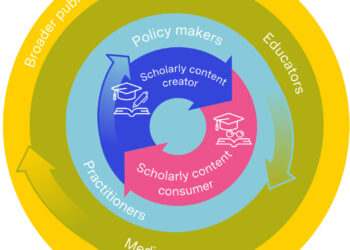
There are three types of people in the world: Those who are good at math, and those who aren’t.
This nice little joke gets us easily into the world of lumpers, a worldview in which signature similarities are sufficient to define groups. A good portion of the media seems to find lumping attractive and worth perpetuating. In the US, we get “red states vs. blue states,” in which millions of people’s complex, shifting, and multi-layered political views are lumped into one color or another. When things get political, lumping contributes to polarization — creating teams sufficiently simple and contentious enough to prepare for battle.
Splitters make much less of a splash in political discourse. These are people who seek nuance, differentiation, and subtlety when approaching a problem or a population. What makes people in rural agrarian Florida different from people in urban cosmopolitan Miami? And what about younger people in each area? Or those who are first-generation citizens compared to those who are second- or third-generation? And what about male or female for all these different possible configurations of identifying characteristics? And so on. Splitters tend to find better answers, but their work is neither sexy nor given to sloganeering. Splitters can spiral down into incoherence if they’re not careful.
The lumping problem appeared during the keynote last night at the SSP Annual Meeting. Dan Cohen, an Associate Professor in the Department of History and Art History at George Mason University and the Director of the Roy Rosenzweig Center for History and New Media, talked about how the scholarly terrain in the humanities is being changed by blogs, curation, and social media tools. Overall, it was a good talk and crisply delivered, but the underlying premise clearly suffered from the lumping problem — the belief that lessons learned within a very specific humanities community (historians) can be generalized to scholarly and scientific publishers in all domains. Historians live in a different ecosystem, with different productivity and funding drivers, than many other domains in academia. Certainly, it’s to be expected that some things might work there which might not work elsewhere.
With the resurgence of open access (OA) debates this past year, and with the technophiles following on their heels, I continue to see lumpers trying to grab the rhetorical reins in scholarly publishing policy debates. These are people who don’t seek differentiation among groups like “publishers” or “authors” or “journals” or “books” or “technology.” I am beginning to believe that this is because when all publishers, journals, authors, books, or technology are lumped together, they make a target. And that target is then used for target practice.
Lumping obscures all goals with one goal.
How has lumping affected our implicit or explicit policy debates? A few things have occurred to me in thinking through the potential issues. I’ve chosen to group the considerations by the agents we lump together.
- Authors — Scholarly authors are mostly reporters, writing up results of studies. Some scholarly authors are more creative — the authors of review articles, special features, and editorials and commentaries. But most authors we talk about in policy debates function as reporters. They want the priority and prestige that go with making news. When these specialized authors are lumped into the broader category of “authors,” which includes writers of popular fiction, authors of current events books, and scribes for weekly magazines, we have a conflation that too often misguides us. Thinking of scholarly reporters and writers as “authors” can mislead us into thinking these people gain value from retaining their copyrights (they don’t, and actually risk both productivity and protection by not turning them over to a professional publisher to register and monitor), or that they want direct payment for their works (only those at the far creative end of the scholarly spectrum usually receive a modest honorarium — the others are compensated indirectly through academic credit, further grants, or both).
- Publishers — “Publishers” are the current scapegoats in scholarly publishing, yet when the lumpers’ view of publishers is untangled a bit, the blame game starts to unravel as well. Do we mean commercial publishers? Multi-national publishers? Not-for-profit publishers? University presses? Society publishers? OA publishers? Academic publishers? Trade publishers? Newspaper publishers? Individual publishers? It’s hard to discern. The Elsevier boycott is perhaps the most poignant example of how misguided this can get. The boycott is about pricing, but a publishing company is associated with the pricing complaint because it creates a simple target, and in the lumpers’ world, it typifies all publishers. Yet, these same people celebrate other publishers, including many of the type (not-for-profit) Elsevier contracts with. Lumping has confused us, and perhaps made it impossible to have a sensible conversation.
- Journals — There are as many journals as there are scientific disciplines, and each audience has slightly different goals. Journals primarily circulating in a closed system of researchers, with few practitioners, are different from journals that seek to inform practitioners of the latest research. Some journals allow supplements, some don’t. Some are online-only, some are not. Some support fields full of patent pressure. Some are purely review journals. Some are policy and thought journals. Some are humanities journals. Some have lots of advertising. Some are published weekly. Some are published continuously. Which “journal” are we talking about when we talk about journals?
- Books — Books are an interesting example of lumping, because the lumping tends to occur around paper books. Yet, reading is more prevalent than ever, even as bookstores disappear and e-readers grow in popularity. Hardcover sales remain strong, while paperback sales are stalling and falling. Clearly, the e-reader is going after the paperback market, except not all paperbacks, since some are doing quite well. In the academic space, patron-driven acquisition (PDA) makes the “just in case” lumping look ill-advised, if only the “just in time” option were completely functional, which it is not yet. And then there are the books like those from the National Academies Press or O’Reilly, which users create from piece-parts of other books.
- Technology — The technology lumpers create the impression that IT and computers are special animals, which cannot be addressed by simpletons like publishers, authors, or editors. They create positions like “chief technology officer” and “chief information officer” and IT offices. Yet, technology has always been integral to publishing, from offset printing to paper manufacturing to ink to distribution logistics. Yes, we need specialists in these areas, but the output is what’s important. Technology is not a separate pursuit of publishers, authors, or editors, but rather a means to an end. It should not stand lumped to the side, but be integrated
Splitters can often exploit lumpers’ broad pronouncements. When I was at the New England Journal of Medicine, the lumpers behind the NIH public access policy made a statement that all journal content should be made freely available to the public within 12 months of publication. NEJM is a weekly journal. We quickly realized that while a monthly would have 12 issues behind it as this window moved, NEJM would have 52 issues, or more than 4x that amount. We therefore instituted a policy that make NEJM articles free after 6 months, elevating us in the eyes of the partisans in this particular debate while actually leaving more than 2x the usual number of issues behind the firewall.
Lumpers also get themselves into policies without realizing how they got there or how the secondary consequences work. Take, for instance, the relatively a priori construction of Gold/Green OA publishing. Now, because everything OA is lumped together as “good,” the difference between Gold and Green is simply a matter of intensity — how good either one is. There is no chance either could be damaging or have unintended consequences. Yet, as splitters like me have pointed out, profit-making, standards-setting, audience-finding, and quality-raising have all potentially worked not as predicted by the OA movement. That is, Gold OA can be highly profitable, yet standards around publication have not risen because of OA journals, audiences are more confused because of the flood of papers OA has unleashed, and the overall quality of the literature (usability, reliability) has not increased. By splitting out these aspirations — quality, standards, and audience orientation — we find a different focus than just “an OA world,” the goal that obscures other, perhaps more important goals.
It’s important to define the terms of a debate — crucial, perhaps. Right now, the lumpers are defining the terms of too many policy debates in scholarly publishing. Perhaps it’s time for the splitters to take a whack, if only to see if they can do better.
Discussion
5 Thoughts on "Lumpers, Splitters, and Policy Debates in Scholarly Publishing"
You sometimes feel like a strong lumper to me here. For example, when you write:
> Scholarly authors are mostly reporters, writing up results of studies.
then I guess you are talking about a specific field or group of fields, because all scholarly authors in fields near mine (mathematics) only report their own findings and are not, as you seem to imply, the mere reporters of other’s findings.
To take another example, when you write
> audiences are more confused because of the flood of papers OA has unleashed
you are lumping together a lot of very different audiences, applying to them what I guess you see around you. Again, I do not see more confusion from the development of the arXiv (which receives most published paper taking advantage of green OA policies in mathematics, physics an computer science). The confusion comes merely from the number of paper published, whose increase is not due to OA in fundamental mathematics since the Gold OA is completely negligible in this field (I do not know any gold OA journal that would consider any of my papers). Confusion is decreased for example by good, trans-publishers databases independently of the article publishing model.
So you are lumping the debate into “lumpers = always bad” and “splitters = always good”? Do I have that right?



